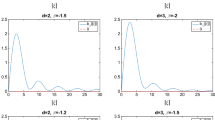Abstract
The Smoothed Particle Hydrodynamics (SPH) method is a meshless Lagrangian method widely used in continuum mechanics simulation. Despite its wide application, theoretical issues of SPH approximation, stability, and convergence are among the unsolved problems of computational mathematics. In this paper, we present the application of dispersion analysis to the SPH approximation of one-dimensional gas dynamics equations to study numerical phenomena that appeared in practice. We confirmed that SPH converges only if the number of particles per wavelength increases while smoothing length decreases. At the same time, reduction of the smoothing length when keeping the number of particles in the kernel fixed (typical convergence results for finite differences and finite elements) does not guarantee the convergence of the numerical solution to the analytical one. We indicate the particular regimes with pronounced irreducible numerical dispersion. For coarse resolution, our theoretical findings are confirmed in simulations.
V.L. did the dispersion analysis under the support of Russian Science Foundation grant no. 21-71-20003, O.S. performed numerical experiments, and T.M. did the asymptotic analysis; O.S. and T.M. work were founded by Russian Science Foundation grant no 21-19-00429, S.A. visualized the results.
Access this chapter
Tax calculation will be finalised at checkout
Purchases are for personal use only
Similar content being viewed by others
References
Ainsworth, M.: Discrete dispersion relation for HP-version finite element approximation at high wave number. SIAM J. Numer. Anal. 42(2), 553–575 (2004)
Ainsworth, M.: Dispersive and dissipative behaviour of high order discontinuous Galerkin finite element methods. J. Comput. Phys. 198(1), 106–130 (2004)
Ainsworth, M., Wajid, H.A.: Dispersive and dissipative behavior of the spectral element method. SIAM J. Numer. Anal. 47(5), 3910–3937 (2009)
Cha, S.-H., Whitworth, A.P.: Implementations and tests of Godunov-type particle hydrodynamics. Mon. Not. R. Astron. Soc. 340, 73–90 (2003)
Cohen, G. (ed.): Metodes numeriques d’ordre eleve pour les ondes en regime transitoire. INRIA (1994). (in French)
Dehnen, W., Aly, H.: Improving convergence in smoothed particle hydrodynamics simulations without pairing instability. Mon. Not. R. Astron. Soc. 425, 1068–1082 (2012)
Gingold, R.A., Monaghan, J.J.: Smoothed particle hydrodynamics: theory and application to non-spherical stars. Mon. Not. R. Astron. Soc. 181, 375–89 (1977)
Grigoryev, V., Stoyanovskaya, O., Snytnikov, N.: Supercomputer model of dynamical dusty gas with intense momentum transfer between phases based on OpenFPM library. J. Phys: Conf. Ser. 2099, 012056 (2021). https://doi.org/10.1088/1742-6596/2099/1/012056
Hubber, D.A., Rosotti, G.P., Booth, R.A.: GANDALF - Graphical Astrophysics code for N-body dynamics and Lagrangian fluids. Mon. Not. R. Astron. Soc. 473, 1603–1632 (2018)
Lisitsa, V.: Dispersion analysis of discontinuous Galerkin method on triangular mesh for elastic wave equation. Appl. Math. Model. 40, 5077–5095 (2016). https://doi.org/10.1016/j.apm.2015.12.039
Liu, Y.: Optimal staggered-grid finite-difference schemes based on least-squares for wave equation modelling. Geophys. J. Int. 197(2), 1033–1047 (2014)
Lucy, L.B.: A numerical approach to the testing of the fission hypothesis. Astron. J. 82, 1013–24 (1977)
Mazzieri, I., Rapetti, F.: Dispersion analysis of triangle-based spectral element methods for elastic wave propagation. Numer. Algorithms 60(4), 631–650 (2012)
Monaghan, J.J.: On the problem of penetration in particle methods. J. Comput. Phys. 82(1), 1–15 (1989)
Monaghan, J.J.: Smoothed particle hydrodynamics. Rep. Prog. Phys. 68, 1703–1759 (2005). https://doi.org/10.1088/0034-4885/68/8/R01
Morris, J.P.: A study of the stability properties of smooth particle hydrodynamics. Publ. Astron. Soc. Austral. 13(1), 97–102 (1996)
Mulder, W.A.: Spurious modes in finite-element discretizations of the wave equation may not be all that bad. Appl. Numer. Math. 30(4), 425–445 (1999)
Price, D.J.: Smoothed particle hydrodynamics and magnetohydrodynamics. J. Comput. Phys. 231(3), 759–794 (2012)
Price, D., et al.: Phantom: a smoothed particle hydrodynamics and magnetohydrodynamics code for astrophysics. Publ. Astron. Soc. Austral. 35, e031 (2020)
Rasio, F.A.: Particle methods in astrophysical fluid dynamics. Prog. Theor. Phys. Suppl. 138, 609–621 (2000)
Quinlan, N.J., Basa, M., Lastiwka, M.: Truncation error in mesh-free particle methods. International journal for numerical methods in engineering Int. J. Numer. Meth. Eng. 66, 2064–2085 (2006)
Springel, V.: The cosmological simulation code gadget-2. Mon. Not. R. Astron. Soc. 364(4), 1105–1134 (2005)
Stoyanovskaya, O.P., Glushko, T.A., Snytnikov, N.V., Snytnikov, V.N.: Two-fluid dusty gas in smoothed particle hydrodynamics: fast and implicit algorithm for stiff linear drag. Astron. Comp. 25, 25–37 (2018)
Stoyanovskaya, O.P., Davydov, M., Arendarenko, M., Isaenko, E., Markelova, T., Snytnikov, V.: Fast method to simulate dynamics of two-phase medium with intense interaction between phases by smoothed particle hydrodynamics: gas-dust mixture with polydisperse particles, linear drag, one-dimensional tests. J. Comp. Phys. 430, 110035 (2021)
Vacondio, R., et al.: Grand challenges for smoothed particle hydrodynamics numerical schemes. Comput. Particle Mech. 8(3), 575–588 (2020). https://doi.org/10.1007/s40571-020-00354-1
Zhang, C., et al.: SPHinXsys: an open-source meshless, multi-resolution and multiphysics library. Softw. Impacts 6, 100033 (2020)
Zhu, Q., Hernquist, L., Li., Y.: Numerical convergence in smoothed particle hydrodynamics. Astrophys. J. 800, Number 1 (2015)
LS-DYNA Homepage. https://www.lstc.com/products/ls-dyna. Accessed 2 Mar 2022
Author information
Authors and Affiliations
Corresponding author
Editor information
Editors and Affiliations
Rights and permissions
Copyright information
© 2022 The Author(s), under exclusive license to Springer Nature Switzerland AG
About this paper
Cite this paper
Stoyanovskaya, O., Lisitsa, V., Anoshin, S., Markelova, T. (2022). Dispersion Analysis of Smoothed Particle Hydrodynamics to Study Convergence and Numerical Phenomena at Coarse Resolution. In: Gervasi, O., Murgante, B., Hendrix, E.M.T., Taniar, D., Apduhan, B.O. (eds) Computational Science and Its Applications – ICCSA 2022. ICCSA 2022. Lecture Notes in Computer Science, vol 13375. Springer, Cham. https://doi.org/10.1007/978-3-031-10522-7_14
Download citation
DOI: https://doi.org/10.1007/978-3-031-10522-7_14
Published:
Publisher Name: Springer, Cham
Print ISBN: 978-3-031-10521-0
Online ISBN: 978-3-031-10522-7
eBook Packages: Computer ScienceComputer Science (R0)




